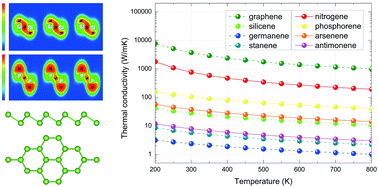The conflicting role of buckled structure in phonon transport of 2D group-IV and group-V materials†
Abstract
Controlling heat transport through material design is one important step toward thermal management in 2D materials. To control heat transport, a comprehensive understanding of how structure influences heat transport is required. It has been argued that a buckled structure is able to suppress heat transport by increasing the flexural phonon scattering. Using a first principles approach, we calculate the lattice thermal conductivity of 2D mono-elemental materials with a buckled structure. Somewhat counterintuitively, we find that although 2D group-V materials have a larger mass and higher buckling height than their group-IV counterparts, the calculated κ of blue phosphorene (106.6 W mK−1) is nearly four times higher than that of silicene (28.3 W mK−1), while arsenene (37.8 W mK−1) is more than fifteen times higher than germanene (2.4 W mK−1). We report for the first time that a buckled structure has three conflicting effects: (i) increasing the Debye temperature by increasing the overlap of the pz orbitals, (ii) suppressing the acoustic–optical scattering by forming an acoustic–optical gap, and (iii) increasing the flexural phonon scattering. The former two, corresponding to the harmonic phonon part, tend to enhance κ, while the last one, corresponding to the anharmonic part, suppresses it. This relationship between the buckled structure and phonon behaviour provides insight into how to control heat transport in 2D materials.



 Please wait while we load your content...
Please wait while we load your content...